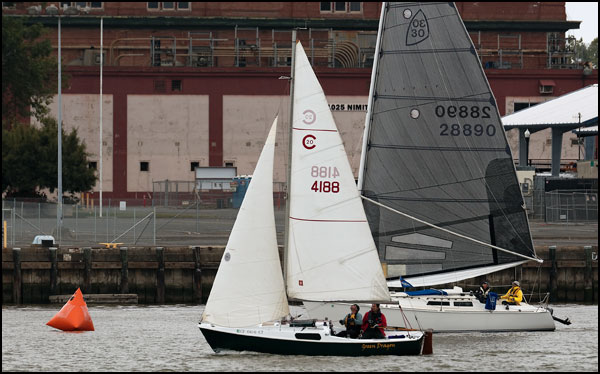
race report
| home contact us movies galleries stories store |

 The Cal 20 Green Dragon and Wyliecat 30 Nancy at the Shorthanded Division start on Sunday under overcast skies in Vallejo's Mare Island Strait. ©2015 Slackwater SF |
|
The Sunday Edition
May 9, 2015 Continued from previous page: After blowing all night, the westerly wind continued Sunday morning as crews awoke, sailors shook off Saturday night's party at Vallejo Yacht Club, and the long walk to the heads began. It was clear that Sunday's race back down San Pablo Bay to the finish line near the east end of the Richmond Bridge was going to be a different animal than Saturday's sunny run up. After a VYC breakfast large enough to stuff a Cal 40's entire crew, the racers in the Shorthanded Division geared up and ventured out into the Mare Island Strait. Two things immediately became apparent. 1) It was flooding. 2) The wind was going to get to the predicted 25-knot range before the day was over. With the reverse start sequence, the Shorthanded Division, along with the smallest PHRF boats, started first. When the gun went off, there was a split between the boats thinking the east side was favored (mostly smaller, less draft) and the west side (mostly larger, deeper draft). The west side seemed to win as the skippers who chose depth and fluky wind caused by Mare Island's various buildings and hills got down to the green Mare Island #1 buoy first. Then came the usual question. Head for the south side and the Conoco refinery pier (where a tanker was tied up) or short-tack the rock seawall on the north side. Leah and I decided short-tacking a Wyliecat 30 would be fun, so we began a series of what finally added up to 35 tacks as we worked our way down the seawall. Tack in until we could count the barnacles on the exposed rocks, tack out until we felt the flood, repeat this again and again and again. It's nice to know the Mare Island seawall is one place in the Bay where silting isn't occurring — nice deep water right up to the rocks! Near the seawall's end we tacked all the way across and into the bight between the Conoco refinery and Pt. Pinole. Now our strategy became a series of longer tacks in until the depthsounder read 9 feet and then out until we felt the current. It seemed we inched our way down toward Pt. Pinole since the tack in often didn't show much progress in a westerly direction. But we were getting there. We counted something like 25 tacks until the final one toward the Pt. Pinole pole. The wind stayed pretty much out of the southwest and increased in speed until we were seeing 30+ knots of apparent wind as we finally passed outside the Pt. Pinole day mark and tacked back into the bight between Pt. Pinole and Pt. San Pablo. We commenced another series of tacks in and out, again using the depthsounder. By this time a few of the larger, faster boats had caught up and we traded tacks in the shallow water, with wind gusts up near 40 knots, and an increasing short, choppy swell. At Pt. San Pablo we passed a few hundred yards north of the buoy and sailed past the Brothers Islands, looking for the finish line — and looking for the larger, faster boats that always seemed on starboard while we were on port. Up until Pt. Pinole we'd kept track of Kynntana since we knew neither Wild 1 nor The Mighty Windsong had started Sunday's race. Now we lost her among all the larger boats catching up. We figured we were far enough ahead to save our time, but continued to press our speed. Little did we know that Rio, Thomas Faraola's yellow Santa Cruz 27 that we had seen all day was racing in our division. It wasn't listed on the YRA information we had, so we figured it was racing in another division. It's hard to miss a yellow hull among all the white ones, so we knew he was there, but we weren't concerned. We stayed high and tacked on Sausalito YC's Mercury which was the committee boat at the north end of the finish line, passing its transom by a few feet. Most of the larger boats finishing at the same time stayed near the south end of the line, which made things easier for us. We figured it had taken us a little more than four hours to sail the 14-mile course. But, with all those tacks — nearly 80 total — we probably sailed an extra 10 miles! Only when YRA published the results did we find out Rio was in our division after all. We beat Rio for first place in the Shorthanded Division in the preliminary results, but then we learned there was a scoring error! Damn! Would it change our finish place? However, we were happy when the corrected results still showed us finishing first. It was one tough afternoon on San Pablo Bay! Wind steady in the 30-knot range with gusts up near 40. An increasing chop as the water got shallow and the wind speed went up. Trading tacks with faster boats that caught up and then passed us.
This year's YRA Great Vallejo Race was one to remember for the dramatic difference in sailing conditions. What will next year's edition bring? — Pat Broderick, Wyliecat 30 Nancy See our norcalsailing.com photo gallery here, and see Slackwater SF's gallery of starts on Sunday here. For results, go to Jibeset.
|